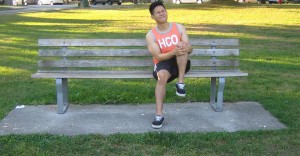Leg cramps while swimming is a sudden and involuntary contractions of the leg muscles. It can be caused by loss of electrolyte, lack of conditioning and unnecessary tension usually affects swimmers. Unnecessary tension such as plantar flexing that is unnatural involuntary action and attempting to correct this unnatural movement will result to cramping.
Causes of leg cramps while swimming
- Lack of sleep
- Entering the water without proper warm up or stretching at 7 minutes of muscles warm up.
- Practicing without eating or drinking
- Stressed and tensed muscles
Treatment
- Get out of the water as soon as possible.
- Stretched and massage the affected area. Gently massage the cramped muscles to make it relax.
Take prescribed pain medications to lessen the pain. - Apply heat on the area. Wrap in a towel a heating pad or hot water bottle before placing to the area to lessen the pain and the cramping. Another alternative is soaking a clean towel in hot water as hot that can be tolerated and place to the area is also good for the condition. Taking a hot shower will lessen the cramping and increase flow of blood in the area.
- Apply an ice pack on the affected area. Bag of frozen vegetable such a peas or corn can also be used.
- Take prescribed pain medications to lessen the pain.
- If the toe cramps, massage the muscles and move the toe forward and backward to release the cramp.
- Fill a tub with warm water; add a cup of Epsom salt. Soak the cramped muscles in the solution for at least 10-15 minutes to lessen the pain, swelling and the spasms.
Tips
- Treat underlying condition that increases the risk of developing leg cramps that includes liver disease or diabetes, nerve compression of the lower back, thyroid disease and poor circulation in the legs.
- Avoid overdoing exercises routines if experiencing frequent leg cramps.
- Stay hydrated during exercises. Drinking water when having leg cramps helps to relieve it to prevent dehydration.
- Increase electrolytes in the body by drinking sports drinks, salt tablets and eating bananas and oranges which are rich in electrolytes. Drink sports beverages that contain magnesium, calcium, sodium and potassium for healthy functioning of the muscles.
- Stretch the muscles before and after performing exercises to increase flow of blood in the area and overall flexibility. It is also for healthy joints and spine and good posture.
- Anticipate development of leg cramps when swimming in cold water. Avoid swimming alone. Cold water weakens the circulation to the leg when swimming.
- Lessen the intensity on swim turn, starts and kicking workouts.
More Information
The details posted on this page on leg cramps is for learning purposes only. To learn to more about the causes and how it is managed, enroll in a first aid course with one of our training providers.
FACT CHECK
https://www.healthlinkbc.ca/health-topics/za1086
https://www.webmd.com/pain-management/muscle-spasms-cramps-charley-horse
https://www.nhsinform.scot/illnesses-and-conditions/muscle-bone-and-joints/conditions/leg-cramps

